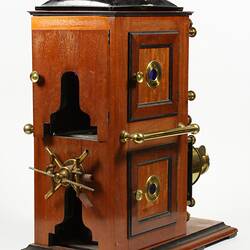Summary
Incomplete mahogany and brass biunial magic lantern manufactured by the London firm of Perken, Son and Rayment. The company professed establishment in 1852 under the name of Lejeune & Perken, becoming Perken, Son & Rayment in 1887. Arthur Rayment left the firm in 1899 and from 1900 the firm operated under the name of Perken, Son & Co. The Optimus trade name was initially registered in 1885 by Lejeune & Perken and was continued under Perken, Son & Rayment. The Optimus name was used to sell a vast range of photographic material, as well as lanterns such as this.
It is believed that the biunial was first conceived by E.G. Wood who was partner with the London instrument makers Horne and Thornthwaite until he left in 1855, The biunial lantern is a system of projection where two lanterns are inbuilt, one on top of the other. This form of projection became possible once the more powerful limelight illuminants were used and quickly became popular. By 1888 it was recorded that over 60 models were being produced, presumably in Britain. The biunial allowed for special effects such as dissolving views to be created by adjusting the brightness of the illuminant in each system.
While the invention of the magic lantern is generally seen to be in the 17th century, its greatest popularity as an optical projector spans the late 18th century to the early decades of the 20th century. It was used both as a means of entertainment and education.
This lantern projector is part of the Francis Collection of pre-cinematic apparatus and ephemera, acquired by the Australian and Victorian Governments in 1975. David Francis was the curator of the National Film and Sound Archive of the British Film Institute as well as being a co-founder of the Museum of the Moving Image in London, which was operational between 1988 and 1999.
Physical Description
Mahogany body lantern. Brass detailing. Black enamelled metal roof with rectangular aperture for insertion of chimney. Brass lens tube with brass controls and swivel lens cover. Flat brass plate slides over front of lower condenser; has circular cutout at top condenser. Top brass lens tube missing. Flat brass flange at front of base. Has cutout slot at centre front for attaching lantern to surface. Each lateral side has two square side-hinged doors into illumination chamber, Each has circular blue glass peep holes. Brass handle right lateral side. Left lateral side has two brass handle holders but handle rail missing. Lower condenser insitu. Single condenser in lower illumination chamber. Illumination chambers are metal lined. Back of lantern body has side-hinged door to top illumination chamber. Door has A-shaped aperture cut out of lower half. Also cut out A at lower illumination chamber. At lower half of back illumination gas piping and controls. Pipes x3 each side. Centre and lower pipe on right side have red rubber tubing still insitu. Two swivel controls for gas, one on each side.
More Information
-
Collection Names
-
Collecting Areas
-
Acquisition Information
Loan & Subsequent Donation from Australian Film Institute (AFI), Mr David Francis, by Nov 1990
-
Collector
Mr David Francis, London, Middlesex, England, Great Britain, 1990
-
Manufacturer
Perken, Son & Rayment, Hatton Garden, London, England, Great Britain, 1887-1900
-
Inscriptions
On rectangular plate on base front: 'MADE BY/PERKEN, SON & RAYMENT/HATTON GARDEN/LONDON. On circular sticker on top of body, handwritten: '50' Embossed on metal lining inside illumination chamber door: 'PERKEN SON & RAYMENT/OPTIMUS/LONDON' Etched onto wooden base at back: 'OPTIMUS' On loose condenser: 'OPTIMUS' On brass controls for illumination gas: Control at right: 'O' Control at left: 'H'
-
Classification
Communications, Audio-visual technology, Image production equipment
-
Category
-
Discipline
-
Type of item
-
Overall Dimensions
490 mm (Length), 265 mm (Width), 560 mm (Height)
-
References
Perken, Son & Rayment, Company Names at 'Early Photography' [Link 1] Accessed 1 April 2011
[Book] Robinson, David, et al. 2001. Encyclopaedia of the Magic Lantern., 2001, 39-40; 168; 215 Pages
-
Keywords
Lantern Projectors, Magic Lanterns, Pre-Cinema Moving Images, Projectors



